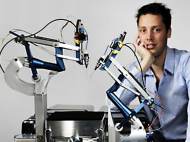Eye-Rhas system employs high precision eye-surgery robot
 Surgery performed on eyes, such as retina repairs or treating a detached retina, demands high precision. Eindhoven University of Technology (TU/e) researcher has developed a smart eye-surgery robot that allows eye surgeons to operate with increased ease and greater precision. The system also extends the effective period during which ophthalmologists can carry out these delicate procedures.
Surgery performed on eyes, such as retina repairs or treating a detached retina, demands high precision. Eindhoven University of Technology (TU/e) researcher has developed a smart eye-surgery robot that allows eye surgeons to operate with increased ease and greater precision. The system also extends the effective period during which ophthalmologists can carry out these delicate procedures.
Eye-Rhas (Eye-robot-for-haptically-assisted surgery) system can simply filter-out hand tremors, which significantly increases the effective working period of the ophthalmologist. The ophthalmologist remains fully in control, and operates by a controller (which researchers defined as master) developed in an earlier PhD project at TU/e by Ron Hendrix.
Two robot arms (which researchers defined as slave), developed by Thijs Meenink, copy the movements and carry out the actual operation. He also designed an instrument changer which allows faster change of instruments such as forceps, surgical scissors and drains. The robot is designed in a way to kinetically detect the entry point and pivot the used instrument at that point in order to prevent damage of the delicate eye structure.
The surgeon’s movements are scaled-down in a way that each centimeter of motion on the controller is translated into a movement of only one millimeter at the tip of the instrument (10:1 scale in movement). The forces used in the operation are usually too small to be felt, but Meenink’s robot can measure these tiny forces and amplify them to provide haptic feedback at the controller system.
The robot used to translate operator’s actions is compact and lightweight enough to be carried by operating room staff, making it easily portable. The whole system provides ergonomic benefits to surgeons, who currently have to be bent in a still position over the patient, because it enables them to operate the robot from a comfortable seated position.
“Robotic eye surgery is the next step in the evolution of microsurgery in ophthalmology, and will lead to the development of new and more precise procedures”, said Marc de Smet, Professor of Ophthalmology at Montchoisi Clinic and one of Meenink’s PhD supervisors.
Eye-Rhas is ready for application and Meenink plans to optimize it in the near future. He also plans to investigate the market opportunities for the slave part of the system.









Leave your response!